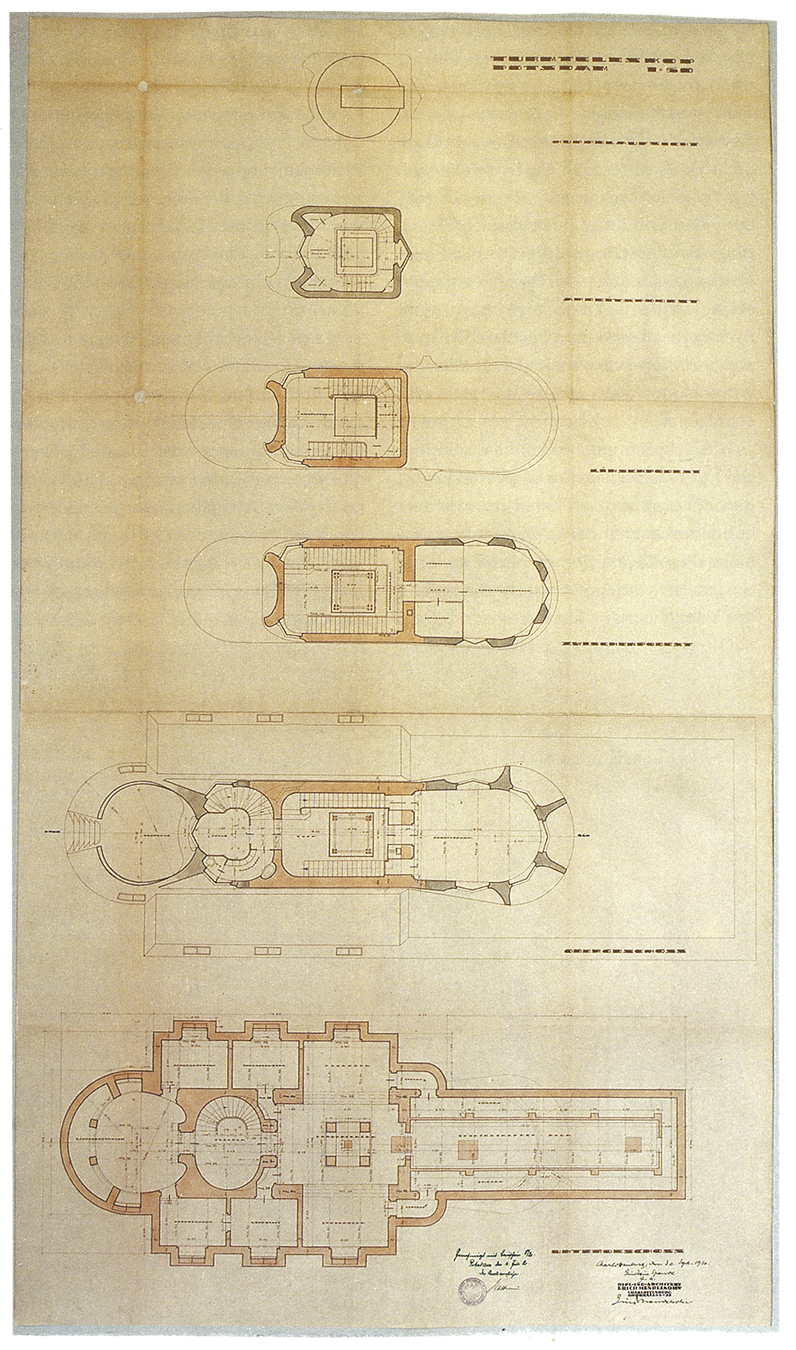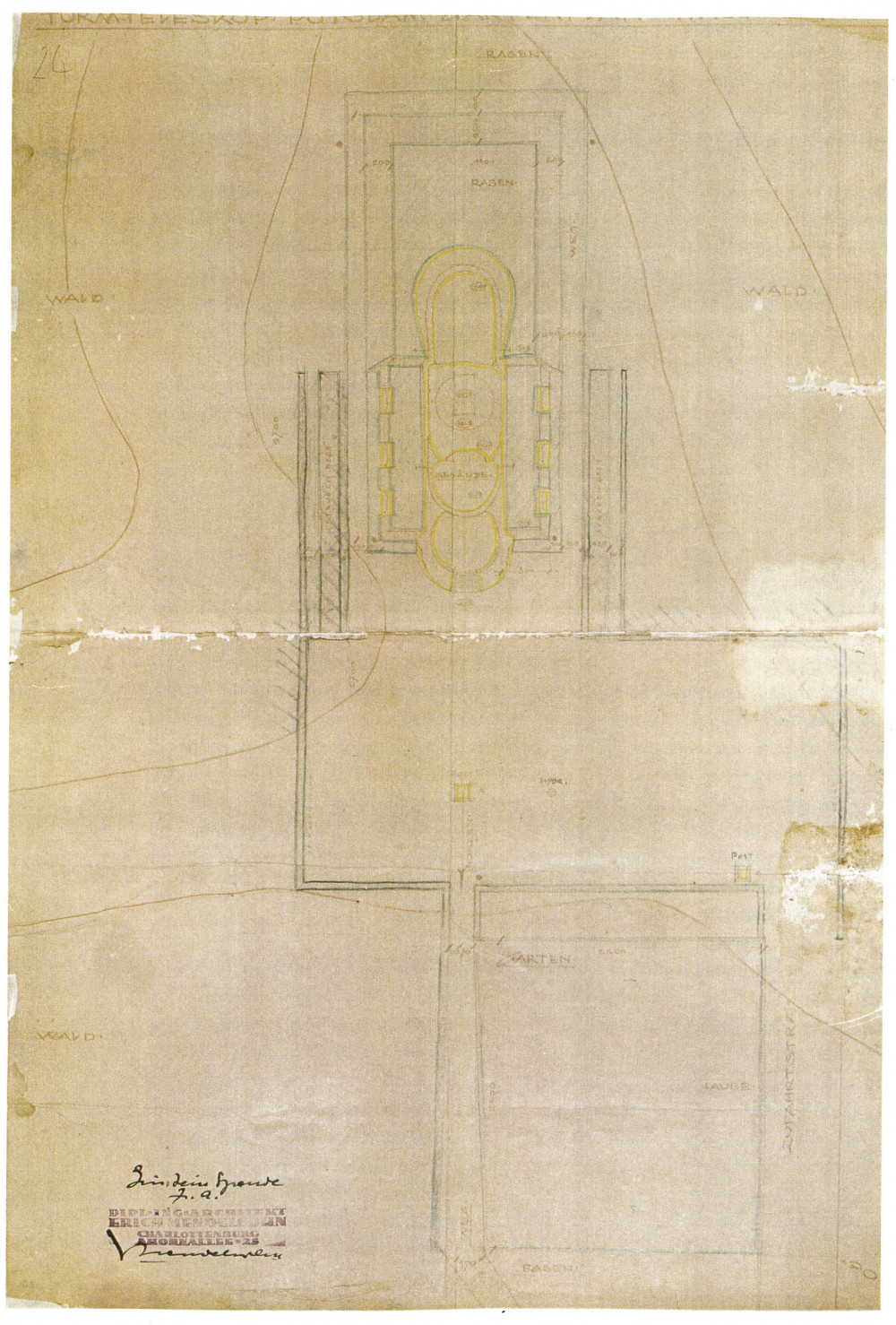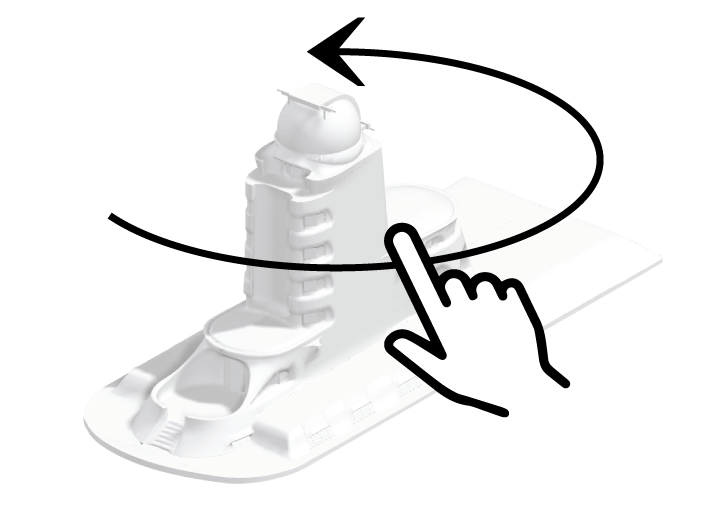Construction work on the Einstein Tower began in September 1920, but the site was promptly shut down as permission had not been granted for the building. Erich MendelsohnErich Mendelsohn (1887–1953) studied architecture at the Charlottenburg (Berlin) and Munich universities of applied sciences. He married Luise Maas in 1915. After returning from the First World War, he founded his own practice in Berlin – it became the best-known and most successful architecture office in Germany. In 1933 he emigrated to England, before moving to Jerusalem in 1939 and then to the USA in 1941. He built important works in all these countries. filed retrospectively for a permit on 30 September 1920, allowing construction to continue. However, this did not put an end to criticism from the building authority. The official line was that insufficient provisions had been made to prevent damp penetration. Mendelsohn did indeed adjust his plans in some places, but on 23 November 1920 the building authority noted that the causes of any future damage to the building would originate in the architectural plans not in their execution.

Composite construction method
The building authority’s main criticisms focused on the ventilation of the laboratory rooms and the drainage in the area of the dome, but it failed to anticipate that the composite construction method would be responsible for the greatest damage. The Einstein Tower is not made entirely of ferroconcrete, which is called reinforced concrete today, but is for the most part built in brick. This probably came about because shuttering was extremely expensive then. Mendelsohn’s frugality in his use of the new material was due not to the scarcity of raw materials but to the formwork, which had to be made by shipbuilders. He only used it for areas where it was absolutely essential in design terms. From today’s perspective, the Einstein Tower can be termed a brick building (solid bricks for walls, hollow bricks for roofs) with reinforced concrete elements (entrance area, workroom and overnight accommodation, and dome). The upper tower ring was cast in concrete to make a more secure connection between the tower and the wooden dome, which is exposed to powerful winds.

Building is experimenting
The special design and the mix of reinforced concrete and brick meant the walls were between 30 and 180 cm thick. There were also notable variations in the thickness of the render. This offset the combination of the different building materials and ensured that the building achieved the form desired by Mendelsohn, with the appearance of having been cast from a single mould. Although the building authority was correct in its warning about damp, it overlooked the real problem. The different masses and thicknesses of the walls and the different materials used in the construction result in variable expansion in response to fluctuations in temperature. This is made more problematic by the north-south orientation of the tower, as required on functional grounds, and inevitably causes cracks to form, which can be repaired but not prevented.
Aside from the design detailing, the decision about the colouring of the tower must also have been made on the building site. The ochre-coloured sprayed render was discovered during the restoration work carried out between 1997 and 1999. Apart from the colour studies in his hand-drawn sketches, there are no extant documents by Mendelsohn in which he remarks on the colour of the tower.
The brickwork for the basement and the tower shaft was completed in November 1920. The shell passed inspection on 10 August 1921, at which point it was possible for the first time to get a sense of the special characteristics of the rooms, and work could proceed on the detailed planning for the design of the walls and ceilings. Even the final version of the plans, as revised by Mendelsohn’s office, does not reflect all the details of the finished building. The Einstein Tower was an experiment influenced by a variety of factors: Mendelsohn’s visionary sketches, the technical requirements of astrophysics and optics, the possibilities of reinforced concrete (which was still almost unknown as a building material), and the skill of the craftsmen working on the construction site.




Time, costs, inflation
The construction costs for the tower amounted to 850,000 Reichsmark (RM), with Mendelsohn’s fee accounting for RM 65,000. The tower’s instrumentation and optical system cost an additional RM 220,000, and a further RM 260,000 was spent on the electrical equipment for experimental purposes. The economy experienced steep inflation from 1920 on, which meant that the available monies from the Einstein Donation Fund and the Prussian government needed to be paid out promptly. Although the final financing did not fall into place until September 1920, it was possible for construction to begin immediately because Freundlich and Mendelsohn had already been working on the project. This accelerated the process of securing a building permit, which was aided too by the Prussian government’s interest in achieving international success in the realm of science.
Politics and antisemitism
At the same time, an anti-Semitic campaign was launched against Albert EinsteinAlbert Einstein (1879–1955) was one of the most important physicists in the history of science. He began developing the theory of relativity in 1905. In 1914 he joined the Prussian Academy of Sciences and in 1917 became director of the Kaiser Wilhelm Institute for Physics, which had been founded for him as a means to support his work. He won the Nobel Prize in 1921 (awarded in 1922). He spent periods teaching and conducting research in the USA. In 1932/33 he went to Princeton, never to return to Germany. He was clearly opposed to Nazi Germany and did not renew his ties with the country, even after 1945. He retired in 1946 and continued his work as professor emeritus at the Institute of Advanced Studies in Princeton., both in the scientific community and in the public sphere. Paradoxically, this had the effect of speeding up work on the Einstein Tower, as the Prussian government was (still) intent on keeping such an important scientist as Einstein in Germany. The extent to which Einstein’s name was used politically is made clear in a letter dated 2 September 1920 from the then German ambassador in London to the Minister of Culture: “Professor Einstein is a cultural factor of the first order for Germany, especially at the present moment, because his name is known in the widest circles. Such a man can be a real driver for cultural propaganda, and we should refrain from exiling him from Germany.” The Minister of Culture subsequently deployed this argument in a letter to the Minister of Finance on 14 September 1920: “It would be intolerable if it was left entirely to foreign nations to continue developing this highly significant theory postulated by a German scholar.”

In Neutras Garten
In early 1922, one and a half years after construction had begun, the building was inspected and approved. In the spring of that year, the first research work was conducted in the Einstein Tower’s laboratory area. However, the outdoor area had not yet been planted, which meant that sand and dust infiltrated the basement rooms. In November 1921, Richard NeutraRichard Neutra (1892–1970), architect, studied architecture at Vienna University of Technology and at Adolf Loos’s architecture school as well as garden architecture in Zurich. In 1921 he began working for the Luckenwalde municipal planning and building control office and designed the forest cemetery there. He worked with Erich Mendelsohn from 1921 to 1923 and was responsible, among other things, for the landscape design for the Einstein Tower., who had yet to make a name for himself, had started working in Mendelsohn’s office. Mendelsohn entrusted him with planning the landscaping for the Einstein Tower. Neutra’s “garden plan” shows that the two steeply inclined banks at the front next to the entrance area and to the side of the tower are not the same height as the somewhat less sloping bank in the southern area to the rear, above the spectrograph room. This shift in levels creates a step in the grassy platform on which the Einstein Tower seems to stand. The lateral paths between the tower and the shrubbery were also realised as per the garden plan. In Neutra’s design, a hedge was to run around the shrubbery, framing a rectangular forecourt in front of the tower. This idea was not implemented, nor was the planting of tall slender trees that Neutra had settled on. Neutra had been working on behalf of Mendelsohn, who was keen to embed the tower more emphatically in the natural landscape surrounding it, even if his ultimate goal was to accentuate the impact of the architecture. However, Mendelsohn did not want to turn the building into a stand-alone structure without any context, especially since the trees in the surrounding wood were then not as tall or as close to the Einstein Tower as they are today.


It was not until 1924 that the telescope with the coelostatA celostat usually consists of two mirrors arranged in a way that a stationary telescope (e.g. a tower telescope) can be used to follow the motion of celestial bodies over the entire course of the day or night. could first be installed. The official opening of the Einstein Tower took place on 6 December 1924 in conjunction with a meeting of the board of trustees of the Einstein FoundationEinstein Foundation: Successor to the Einstein Donation Fund. Board of trustees of the Einstein Donation Fund: Albert Einstein, Gustav Müller (director of the AOP, 1917–21), Erwin Finlay Freundlich and Rudolf Schneider (managing director of the Reich Association of German Industry). In 1921 it was converted into the Einstein Foundation. The board of trustees now also included Hans Ludendorff, the lawyer Ludwig Ruge, and Carl Bosch (director of BASF) as well as two representatives of the Prussian Ministry of Education and Cultural Affairs and other representatives from the realms of industry, science, and politics..



